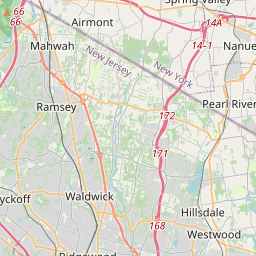Victorian Tea Party
Historical marker location:
335 North Franklin Turnpike, Ho Ho Kus, New Jersey
( Marker can be reached from North Franklin Turnpike (County Route 507), on the right when traveling south.)







© OpenStreetMap contributors
Loading...
Searching for other points of interest within 3 miles of this location.The oldest lighthouse in the United States, the Sandy Hook Lighthouse, is located in New Jersey. The lighthouse was built in 1764 and still functions as an aid to navigation.
About Bergen County
Bergen County Timeline
Bergen County, located in the northeastern part of New Jersey, has a rich and varied history. The area was originally inhabited by Native American tribes such as the Lenape people, who lived along the Hackensack River and hunted and fished in the region. European settlement began in the 17th century when Dutch settlers established trading posts and farms. The Dutch West India Company purchased the land in the early 17th century, and it became known as Bergen, after the Dutch city of Bergen op Zoom.
During the American Revolution, Bergen County played a significant role. British troops occupied parts of the county, and the area witnessed numerous skirmishes and battles. One notable event was the Battle of Fort Lee, where General George Washington ordered the evacuation of his troops in the face of a British attack. After the war, Bergen County experienced population growth, with more diverse groups of people settling in the area.
In the 19th century, Bergen County saw significant development and industrialization. The construction of the Erie Canal and later, the railroads, helped connect Bergen County to New York City and facilitated the growth of manufacturing and commerce. Towns like Hackensack, Englewood, and Paterson became important centers of industry and trade. Additionally, the opening of the George Washington Bridge in 1931 further enhanced the county's accessibility and spurred suburbanization.
Today, Bergen County is a bustling and thriving suburban region. It is known for its diverse communities, excellent educational institutions, and proximity to New York City. The county offers a wide range of recreational and cultural attractions, including parks, museums, shopping malls, and dining options. With a combination of historical significance and modern amenities, Bergen County remains an attractive place to live, work, and visit.
During the American Revolution, Bergen County played a significant role. British troops occupied parts of the county, and the area witnessed numerous skirmishes and battles. One notable event was the Battle of Fort Lee, where General George Washington ordered the evacuation of his troops in the face of a British attack. After the war, Bergen County experienced population growth, with more diverse groups of people settling in the area.
In the 19th century, Bergen County saw significant development and industrialization. The construction of the Erie Canal and later, the railroads, helped connect Bergen County to New York City and facilitated the growth of manufacturing and commerce. Towns like Hackensack, Englewood, and Paterson became important centers of industry and trade. Additionally, the opening of the George Washington Bridge in 1931 further enhanced the county's accessibility and spurred suburbanization.
Today, Bergen County is a bustling and thriving suburban region. It is known for its diverse communities, excellent educational institutions, and proximity to New York City. The county offers a wide range of recreational and cultural attractions, including parks, museums, shopping malls, and dining options. With a combination of historical significance and modern amenities, Bergen County remains an attractive place to live, work, and visit.
Bergen County Timeline
This timeline provides a concise overview of the key events in the history of Bergen County, New Jersey.
- 1683 - Bergen County is established as one of New Jersey's original counties.
- 1660s-1700s - European settlers, primarily of Dutch and English descent, start to establish settlements in Bergen County.
- 1776-1783 - Bergen County plays a crucial role in the American Revolutionary War, with notable battles occurring at Fort Lee and New Bridge Landing.
- 19th century - Industrialization and urbanization lead to significant growth in Bergen County, attracting immigrants from various European countries.
- 1840 - The Northern Railroad of New Jersey opens, increasing connectivity and facilitating further economic development.
- 20th century - Suburbanization becomes a dominant trend, with many residents commuting to New York City for work.
- 1946 - Bergen Community College, the largest community college in New Jersey, is established.
- 1970s-1980s - Bergen County experiences a surge in population and construction, accompanied by commercial and retail development.
- 1990 - Bergen County's last remaining farm is sold, marking the end of the county's agricultural era.
- Present - Bergen County has a diverse population and is known for its wealth, cultural institutions, and proximity to New York City.